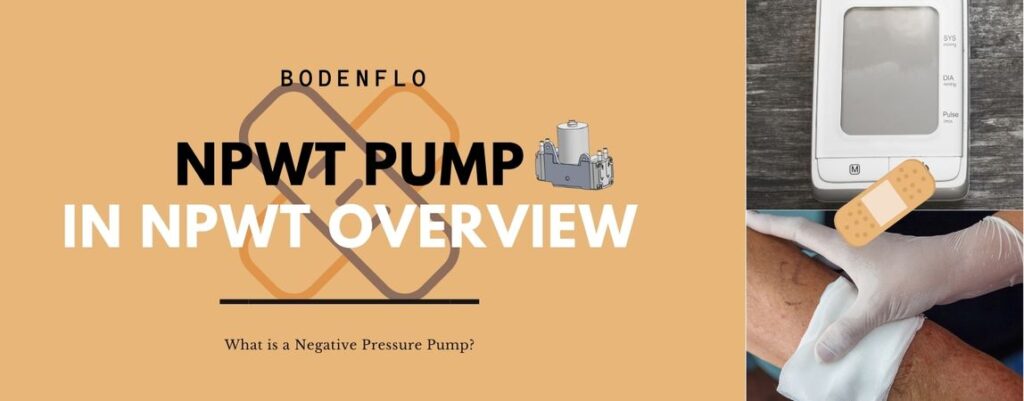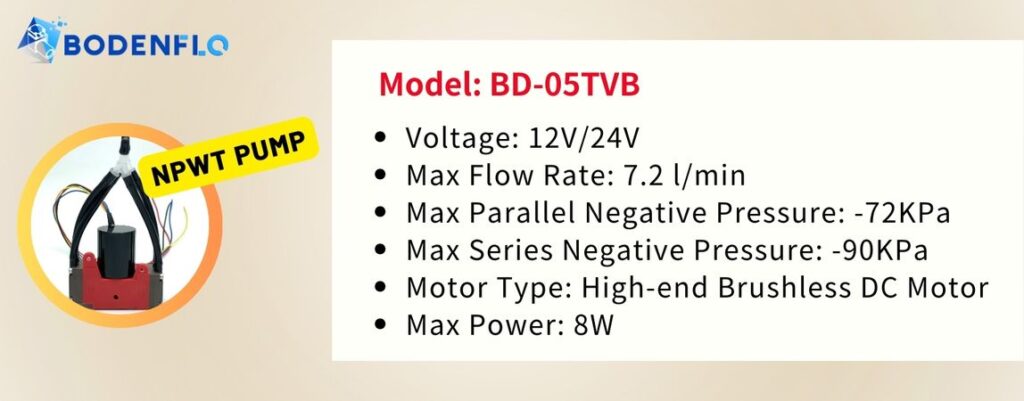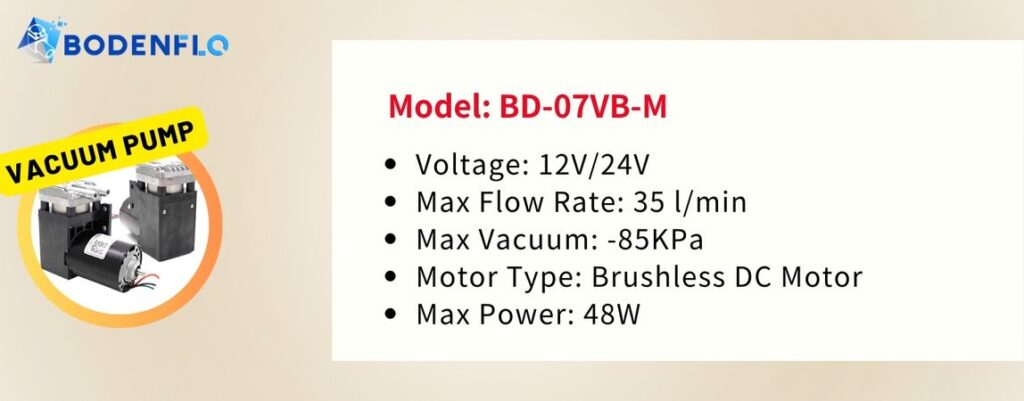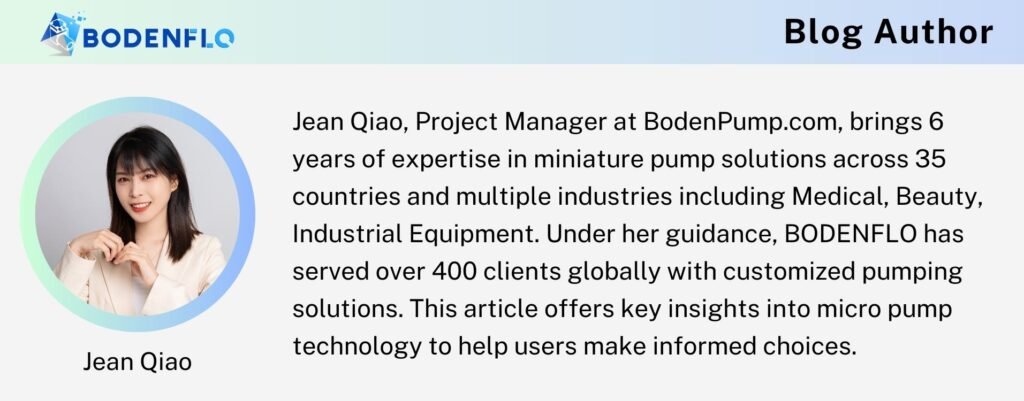
In the realm of medical and industrial applications, negative pressure pumps play a pivotal role in creating a controlled environment for various processes. This article delves into the world of Negative Pressure Wound Therapy (NPWT) pumps, also known as wound vacuums, exploring their significance, functionality, and the crucial role they play in healthcare and other industries.
What is a Negative Pressure Pump?
Negative Pressure Pumps, often referred to as suction pumps, vacuum pump, are remarkable devices that play a pivotal role in creating controlled vacuum or negative pressure environments. Their application spans a multitude of industries, making them indispensable tools for various processes. In this section, we will delve into the profound significance of these pumps, shedding light on their definition, purpose, and the diverse sectors they serve.
Definition and Purpose
A Negative Pressure Pump, at its core, is a precision-engineered device designed to generate a vacuum or negative pressure within a confined space or system. This innovative technology operates on the principle of extracting air or fluids from an area, creating a vacuum that can be tailored to specific requirements.
The primary purpose of these pumps is to manipulate pressure conditions, offering a wide range of applications across numerous industries. They are instrumental in maintaining the desired pressure levels in diverse environments, allowing for enhanced control and precision in various processes.
Applications in Different Industries
Negative Pressure Pumps find extensive use in a multitude of industrial sectors due to their exceptional versatility. Here, we explore some key applications:
1. Healthcare
Negative Pressure Pumps play a pivotal role in the healthcare sector, particularly in Negative Pressure Wound Therapy (NPWT). They are used to create controlled suction around wounds, aiding in faster healing by removing excess fluids, promoting tissue growth, and reducing the risk of infection. This technology has revolutionized wound care and is widely embraced by healthcare professionals worldwide.
2. Vacuum Sealing

In the food industry, negative pressure pumps are employed for vacuum sealing, a process crucial for preserving the freshness and quality of food products. By removing air from packaging, these pumps create an airtight seal that extends the shelf life of perishables, preventing spoilage and reducing food waste.
3. Pressure Control
In manufacturing, negative pressure pumps are vital for precise pressure control within chambers and systems. This capability is essential for tasks such as material synthesis, chemical reactions, and quality testing, where maintaining specific pressure conditions is critical to achieving desired outcomes.
4. Fluid Transfer
Industries like pharmaceuticals, petrochemicals, and biotechnology rely on negative pressure pumps for the safe and efficient transfer of liquids and gases. These pumps ensure that substances are moved with precision and care, minimizing the risk of spills and contamination.
The NPWT Pump: An In-Depth Look
The world of healthcare relies heavily on specialized equipment and technologies to enhance patient care and recovery. Among these innovations, NPWT pumps, or Negative Pressure Wound Therapy pumps, occupy a vital position. In this section, we delve into an in-depth exploration of NPWT pumps, shedding light on their essential role in healthcare, the key components that drive their effectiveness, and the significant advantages they bring to the field of medical wound management.

2.1 NPWT Pump Overview
NPWT pumps, sometimes referred to as wound vacuums, represent a unique category of negative pressure pumps meticulously engineered for the healthcare sector. Their primary function is integral to a process known as Negative Pressure Wound Therapy (NPWT). This therapy involves the application of controlled suction to wounds, and NPWT pumps are the cornerstone of this treatment.
Specialization for Healthcare
Unlike general-purpose negative pressure pumps, NPWT pumps are purpose-built for healthcare settings. They are designed to meet the stringent requirements of medical applications, ensuring precision, reliability, and patient safety.
2.2 Key Components and Features
To comprehend the effectiveness of NPWT pumps in wound care and healing, it is essential to explore their key components and features. These components work in harmony to provide optimal results in wound management.
Components
- Vacuum Source: NPWT pumps are equipped with a powerful vacuum source that creates controlled negative pressure.
- Wound Interface: Specialized dressings or wound interfaces are used to cover the wound and connect to the pump.
- Collection Canister: The pump collects exudate and fluids from the wound in a separate canister.
- Control Unit: NPWT pumps are often accompanied by control units that allow healthcare professionals to set and monitor pressure levels.
Features
- Adjustable Pressure: NPWT pumps offer adjustable pressure settings to cater to various wound types and stages of healing.
- Continuous Monitoring: They incorporate monitoring systems to ensure that pressure remains within the prescribed range.
- Portability: Many NPWT pumps are designed with portability in mind, allowing patients greater mobility during treatment.
- Battery Backup: To ensure uninterrupted therapy, some pumps come with battery backup options.
2.3 How NPWT Pumps Benefit Healthcare
The advantages of NPWT pumps in the healthcare field, particularly in wound management, cannot be overstated. Their impact is multifaceted:
Enhanced Healing
NPWT pumps create an environment that promotes wound healing by removing excess fluids, facilitating tissue granulation, and reducing the risk of infection. This leads to faster recovery times and improved patient outcomes.
Reduced Hospital Stay
The use of NPWT pumps can often result in shorter hospital stays, reducing healthcare costs and allowing patients to return to their daily lives more swiftly.
Minimized Complications
By effectively managing wound exudate and infection risk, NPWT pumps help minimize complications, ensuring a smoother recovery process for patients.
Is a Wound Vac a Suction Pump?
In the realm of medical terminology, the distinction between various types of pumps can sometimes become blurred, leading to questions about the relationship between specific pump types. One common query revolves around the comparison between Wound Vacuums (Wound Vacs) and suction pumps. In this section, we aim to provide clarity on this matter, starting with an understanding of suction pumps and then delving into the intricate relationship between Wound Vacs and the broader category of suction pumps.
3.1 Understanding Suction Pumps
Suction Pumps in a Nutshell
Suction pumps, as the name suggests, are devices designed to create a vacuum or suction within a given space. They find application across a wide array of industries and functions. In essence, a suction pump extracts air or fluids from an area, resulting in lowered pressure or the creation of a vacuum.
Versatile Applications
Suction pumps serve diverse purposes, from industrial settings where they facilitate fluid transfer and pressure control to healthcare, where they are used for various applications, including wound management. Their versatility stems from their ability to generate and maintain controlled suction.
3.2 The Relationship Between NPWT Pumps and Suction
The Wound Vac's Connection
A Wound Vac, short for Wound Vacuum Assisted Closure, is indeed a form of suction pump, but it is specialized for a particular medical application. Specifically, a Wound Vac is a type of negative pressure pump tailored to the healthcare sector and primarily used in Negative Pressure Wound Therapy (NPWT).
NPWT and Controlled Suction
The crucial link between NPWT pumps, such as Wound Vacs, and suction pumps lies in their shared ability to create controlled suction. In the context of NPWT, a Wound Vac applies precisely regulated suction to a wound site. This controlled suction serves the purpose of removing excess fluids, encouraging tissue growth, and expediting the wound healing process.
Exploring Negative Suction Pressure on a Pump
The concept of negative suction pressure in pump systems is fundamental to understanding the dynamics of fluid and gas movement in various industries. In this section, we delve into the intricacies of negative suction pressure, beginning with its definition and then delving into its critical significance in the operation of different pump types. Understanding this aspect is essential for professionals working with pumps, as it directly impacts performance and efficiency.
4.1 Negative Suction Pressure Defined
Defining Negative Suction Pressure
Negative suction pressure, often referred to simply as suction pressure or vacuum pressure, is a measure of the force created within a pump system to draw in fluids or gases from their source. It represents the relative decrease in pressure compared to the atmospheric pressure. In essence, it is the vacuum force that drives the intake of substances into the pump.
Creating a Vacuum
To create negative suction pressure, pumps utilize various mechanisms, such as impellers, diaphragms, or pistons, to reduce the pressure inside a sealed chamber or system. This reduction in pressure prompts the fluid or gas at the inlet to move into the pump, allowing for its subsequent transport or manipulation.
4.2 Its Significance in Pump Operations
Ensuring Efficient Fluid Transfer
Negative suction pressure is of paramount importance in pump operations across industries. It determines the pump's ability to efficiently draw in and move fluids or gases from one location to another. The level of negative suction pressure directly affects the rate at which substances can be transported, making it a critical factor in achieving desired flow rates.
Overcoming Head and Friction
In addition to enabling the transfer of substances, negative suction pressure plays a vital role in overcoming head pressure and friction within the pump system. Head pressure refers to the vertical distance between the source and destination of the fluid or gas, and negative suction pressure ensures that the pump can lift and transport the substance effectively. Moreover, it counters the resistance created by friction as the fluid or gas moves through pipes and components.
Maintaining Pump Integrity
While negative suction pressure is essential for pump functionality, it's crucial to maintain it within safe limits. Excessive negative suction pressure can lead to cavitation, a phenomenon where vapor bubbles form and implode within the pump, causing damage and reducing efficiency. Proper design and control of negative suction pressure are critical to prevent such issues.
Mechanics Behind a Negative Suction Pump
The mechanics underlying a negative suction pump are essential to grasp for those seeking a comprehensive understanding of these devices. In this section, we embark on an exploration of the operational principles and the intricate components that drive the creation and maintenance of negative pressure in suction pumps. This knowledge is fundamental for professionals involved in the design, operation, and maintenance of these pumps.
5.1 Operational Principles
Understanding the Working Principles
Negative suction pumps operate based on the fundamental principle of pressure differentials. They are designed to create a lower pressure area at the pump's inlet compared to the external environment. This pressure difference compels fluids or gases to flow into the pump, facilitating their transfer or manipulation.
Role of the Pump Mechanism
The heart of a negative suction vacuum pump lies in its mechanism, which can take various forms such as impellers, diaphragms, or pistons. These mechanisms are responsible for changing the volume of a sealed chamber within the pump. As the chamber volume increases, the pressure within it decreases, creating a vacuum effect that draws in the substance to be pumped.
5.2 Components That Enable Negative Suction
The Vacuum Source
Central to the operation of a negative suction pump is the vacuum source, which generates the necessary pressure differential. This source can be a mechanical component or a system that reduces the pressure within the pump chamber. Common examples include rotary vane pumps and diaphragm pumps.
Sealing Mechanisms
To maintain the integrity of the vacuum created, suction pumps are equipped with sealing mechanisms. These mechanisms prevent air or gas from leaking into the pump chamber from the surroundings, ensuring that the pressure differential is maintained consistently.
Valves and Control Systems
Control over the pressure differential is crucial for efficient operation. Valves and control systems are integral components that enable the adjustment and regulation of suction pressure. They play a vital role in fine-tuning the pump's performance to meet specific requirements.
Monitoring and Safety Measures
Modern negative suction pumps often incorporate monitoring systems and safety measures to prevent issues like cavitation or overheating. These features ensure the pump operates reliably and safely over extended periods.
Negative Pressure Vacuum: Beyond Healthcare
While Negative Pressure Wound Therapy (NPWT) has been a focal point in our discussion, the utility of negative pressure vacuum technology extends far beyond the realm of healthcare. In this section, we explore the vast landscape of industrial applications for negative pressure vacuum systems. From manufacturing to research and development, these systems play a pivotal role in enhancing processes and achieving superior results.
6.1 Industrial Applications
Versatility in Manufacturing
Negative pressure vacuum technology finds extensive use in manufacturing industries. It enables precision control over various processes, such as molding, casting, and drying. By removing air and moisture from materials and molds, manufacturers can achieve consistent product quality and reduced defects.
Moreover, negative pressure vacuum systems have found their way into specialized manufacturing equipment like industrial 3D printers and PCB (Printed Circuit Board) prototyping machines. In 3D printing, vacuum technology can improve layer adhesion, ensuring that each layer bonds effectively to its predecessor, thereby improving the structural integrity of the final product.
Vacuum Lifters: Enhancing Productivity
Vacuum lifters are another vital component in the efficient handling of materials. Unlike traditional lifting equipment, vacuum lifters use suction to lift and move materials, which offers a range of advantages. These include better grip, reduced product damage, and minimal manual handling, thereby reducing the risk of workplace injuries.

Research and Development
Scientific research often relies on negative pressure vacuum systems for critical applications. Vacuum chambers, for instance, are used in material testing, electronic component manufacturing, and space simulation. These systems create controlled environments where experiments can be conducted under specific pressure conditions.
6.2 Advantages of Utilizing Negative Pressure Vacuum
Enhanced Process Control
One of the primary advantages of incorporating negative pressure vacuum systems in industrial processes is the enhanced control they offer. By adjusting the level of vacuum, operators can precisely manipulate conditions to achieve desired outcomes.
Improved Product Quality
The removal of air and moisture during manufacturing processes ensures product quality and consistency. This is particularly important in industries such as electronics and aerospace, where even minor defects can have significant consequences.
Energy Efficiency
Negative pressure vacuum systems are known for their energy efficiency. By removing excess air, they reduce energy consumption, making them environmentally friendly and cost-effective.
Automation and Labor Savings
The automation capabilities of vacuum systems reduce the need for manual labor, improving safety and efficiency while minimizing human error.
The Role of BODENFLO as a Negative Pressure Pump Manufacturer/Supplier

As we conclude our professional overview of negative pressure pumps and their multifaceted applications, it is imperative to spotlight the pivotal role of BODENFLO as a distinguished manufacturer and supplier in this niche market. BODENFLO stands as a beacon of innovation and expertise in the realm of customizable and OEM high-pressure, vacuum, and flow micro pumps. In this final section, we shed light on BODENFLO's core strengths and its commitment to meeting the diverse needs of industries worldwide.
7.1 Customization and OEM Capabilities
Tailored Solutions
BODENFLO prides itself on its unmatched customization capabilities. Understanding that each industry and application may have unique requirements, BODENFLO collaborates closely with clients to engineer tailored solutions. Whether it's adjusting pressure levels, flow rates, or specific design features, BODENFLO's team of experts ensures that every pump aligns precisely with the client's needs.
OEM Partnerships
Recognizing the importance of Original Equipment Manufacturer (OEM) partnerships, BODENFLO offers opportunities for businesses to brand its high-quality pumps as their own. This strategic approach enables OEMs to provide cutting-edge pump technology to their clients while maintaining their brand identity.
7.2 Meeting the Needs of Different Industries
Diverse Clientele
BODENFLO's commitment to excellence extends across a diverse clientele, spanning healthcare, manufacturing, research, and more. Its pumps find applications in wound care, industrial manufacturing, and scientific research, among others. By understanding the specific demands of each industry, BODENFLO ensures that its products contribute significantly to the success of its clients' operations.
Precision and Reliability
In healthcare, where precision is paramount, BODENFLO's micro pumps play a vital role in supporting medical professionals in their mission to provide top-notch patient care. Similarly, in the industrial sector, BODENFLO's pumps uphold standards of reliability, enabling consistent production processes.
7.3 Reaching Global Markets
Global Presence
BODENFLO has established a strong presence in key export countries, including Europe, the United States, Brazil, Australia, South Korea, Canada, and Russia. Its pumps are sought after by clients worldwide for their quality, reliability, and adaptability.


